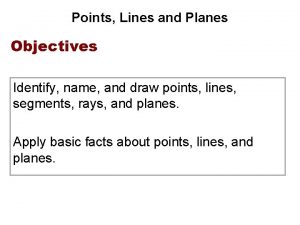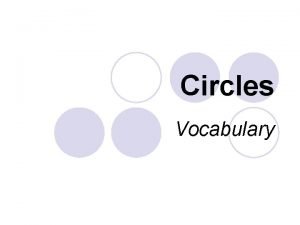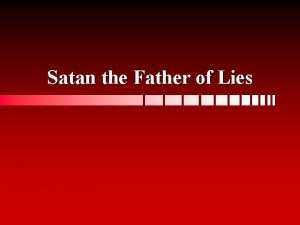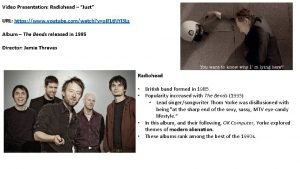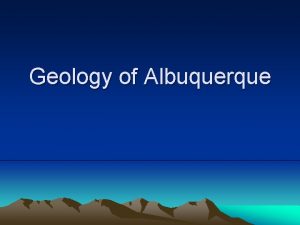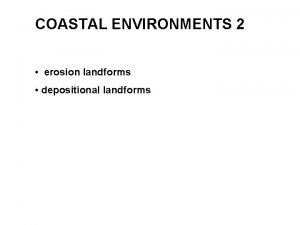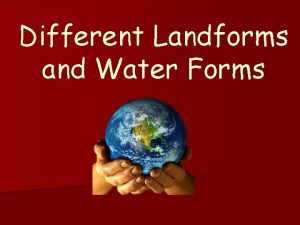GEOLOGY OF MINNESOTA Minnesota Landforms Minnesota lies in














- Slides: 14

GEOLOGY OF MINNESOTA Minnesota Landforms

Minnesota lies in the middle of the North American Craton These rocks are more than 545 million years old They are referred to as Precambrian Anything older than 600 million years old MINNESOTA’S ROCKS ARE OLD

Weathering is the decay and breaking of rocks into smaller pieces. Weathering is the result of the interactions of air, water, and temperature on exposed rock surfaces and prepares the rock for erosion. Erosion is the movement of the particles by ice, wind, or water. The particles are then transported by that agent until they are deposited to form sedimentary deposits, which can be later eroded again or transformed into sedimentary rocks. WEATHERING & EROSION

Mechanical weathering is the physical breaking of rocks into smaller pieces (the composition of the rocks stay the same). Example: Rocks hitting other rocks in a river (caused by the moving water) physically breaks off the sharp edges and rounds the rocks. Chemical weathering is the breakdown or decay of rocks by chemically changing the composition of the rock. Example: A weak acid (such as vinegar) will breakdown limestone by chemically changing some of the rock into a gas (carbon dioxide, CO 2) which bubbles off. TWO TYPES OF WEATHERING

A spherically weathered boulder forms when the corners of an angular rock are broken down more quickly than the flat surfaces, forming rounded shapes. Differential weathering results when some rocks resist weathering more than other rocks, creating uneven rates of weathering and erosion. WEATHERING PATTERNS

Exfoliation: the peeling away of outer layers of a rock when pressure is taken off the rock, or when the rock expands & contracts due to temperature change. WEATHERING TERMS - MECHANICAL

Ice Wedging: water freezing and thawing in the cracks of rock can break it apart and allow the water to seep deeper. WEATHERING TERMS - MECHANICAL

Organic Activity: as plant roots grow they can force apart rocks, and animals and insects can dig and breakdown rock. WEATHERING TERMS - MECHANICAL

Abrasion: rocks hitting each other can breakdown the outer surface of the rocks. Abrasion can be caused by: 1. Water currents in rivers and streams forcing rocks to hit each other. 2. Water in ocean waves crashing against shorelines can pound rock into smaller pieces. 3. Wind carrying sand can breakdown and “sandblast” rock. 4. Glaciers (containing bits of sand rock) sliding down mountains can grind against the underlying rock and break some of it off. WEATHERING TERMS - MECHANICAL

Hydrolysis: when water chemically reacts with, and changes, the minerals in rock. WEATHERING TERMS - CHEMICAL

Carbonation: when carbonic acid reacts with, and changes, the minerals in rock (CO 2 bubbles are released). WEATHERING TERMS - CHEMICAL

Oxidation: when oxygen from water or the air reacts with and changes metallic elements in rock. Note: rust is one form of oxidation. WEATHERING TERMS - CHEMICAL

Other Acid Reactions: acid can react with and change the minerals in rock. The acid can be naturally occurring (example: moss and lichens which grown on rocks) or can be manmade (example: acid rain caused by air pollution). WEATHERING TERMS - CHEMICAL

Move about the room to the different stations Follow the directions at each station Draw a picture of what happened Describe what happened List the type of Mechanical or Chemical erosion demonstrated on the blank provided ACTIVITY: WEATHERING STATIONS
 The dante project synopsis
The dante project synopsis The difference between right and wrong is clear
The difference between right and wrong is clear Theme statement
Theme statement Lies allard
Lies allard Example of simile sentence
Example of simile sentence Les dir oder lies dir
Les dir oder lies dir Damned lies and statistics summary
Damned lies and statistics summary Name
Name Geometry circle vocabulary
Geometry circle vocabulary Cut grass by philip larkin
Cut grass by philip larkin There are three kinds of lies
There are three kinds of lies Tony robbins evening power questions
Tony robbins evening power questions Where the blame lies cartoon meaning
Where the blame lies cartoon meaning Satan the father of lies
Satan the father of lies Radiohead video everyone lies down
Radiohead video everyone lies down







